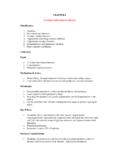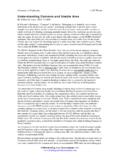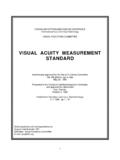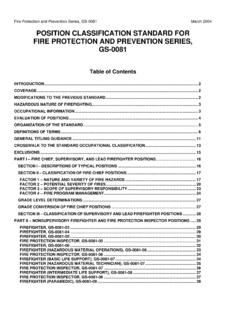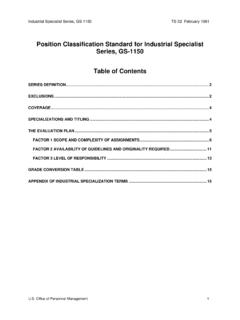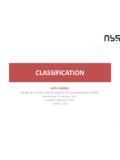Transcription of 6 Classification Schemes - Hinkelmann
1 6 Classification SchemesProf. Dr. Knut Hinkelmann26 Classification SchemesOrganizing Information Objective: finding a way through the overwhelming volume of material. Approach: organize information into patterns with related itemsbrought together Information collections used by many people are organized in a way that correspond to the needs of most users, the navigation on the intranet or on a homepage the arrangement of books in libraries or bookshopssupport users in searching Information collections for individual use are also organized the order of paper files reflects the way you normally use them file management on a computer groups items according to theirshared characteristics, the nature of the item (software, document.)
2 Database etc) the project referenceProf. Dr. Knut Hinkelmann36 Classification SchemesClassification Classificationis an organization means arranging information itemsinto classes - dividing theuniverse of informationinto manageableand logical portions. A classorcategoryis a group of concepts that have something in common. This shared property gives the class its identity. Classifications may be designed for various purposes like scientific Classification Classification for information indexing and retrieval A class may be further divided into smaller classes (or subclasses), and so on, until no further subdivision is feasible.
3 So Classification islikely to : UDConline( )Prof. Dr. Knut Hinkelmann46 Classification SchemesUse of Classification schemesClassification Schemes can be used to physically group items, books in a library or retail goods in a supermarket papers in a file cabinet logically organize references to information objects - in otherwords: metadata- , directory on a computer internet directory yellow pages systemfile systemonlinephysicalProf. Dr. Knut Hinkelmann56 Classification SchemesTypes of Classification systemsFlat Organisation: no structure betweencategoriesTaxonomy: categories arranged in a hierarchical structurerelated things are grouped togetherProf.
4 Dr. Knut Hinkelmann66 Classification SchemesClassification Schemes The Classification scheme can be decided locally represent a consensusThe greater the quantity or complexity of items, the more helpful it isto follow a ready-made Classification scheme, which represents a consensus as to a helpful order of classes Classification Schemes may be either: special, limited to a specific domain of interest; or general, aiming to cover all subjects equally('the universe of information'). Three most widely used general Classification Schemes are : Dewey Decimal Classification (DDC) Universal Decimal Classification (UDC) Library of Congress Classification (LCC)Prof.
5 Dr. Knut Hinkelmann76 Classification SchemesExample: Universal Decimal Classification (UDC)0 GENERALITIES1 PHILOSOPHY. PSYCHOLOGY2 RELIGION. THEOLOGY3 SOCIAL SCIENCES4 VACANT5 NATURAL SCIENCES6 TECHNOLOGY7 THE ARTS8 LANGUAGE. LINGUISTICS. LITERATURE9 GEOGRAPHY. BIOGRAPHY. HISTORY0 GENERALITIES1 PHILOSOPHY. PSYCHOLOGY2 RELIGION. THEOLOGY3 SOCIAL SCIENCES4 VACANT5 NATURAL SCIENCES6 TECHNOLOGY7 THE ARTS8 LANGUAGE. LINGUISTICS. LITERATURE9 GEOGRAPHY. BIOGRAPHY. HISTORY004 Computer science and intelligence Consultation expert systems004 Computer science and intelligence Consultation expert systems The Universal Decimal Classification (UDC) is a Classification scheme for all fields of knowledge and knowledge representation.
6 UDC was originally created to organize a universal bibliography UDC was created in 1895, it has been translated into over thirty languages The scheme is updated annually, its standard version - known as the Master Reference File (MRF) - is available electronically in English language, The UDC is structured in a hierarchical manner, based on ten main classesThe classes are further divided decimally. The notation is basically arabic numerals: Dr. Knut Hinkelmann86 Classification SchemesApplications of UDC libraries shelf arrangement information retrieval (classified catalogues) collection management (acquisition, circulation statistics, weeding) museums and archives collection management objects indexing and retrieval collection display bibliographies and bibliographic databases subject information navigation information retrieval information services selective dissemination of information (user's profile description) Internet subject gateways (information presentation and navigation)
7 Metadata (information discovery) As a source for building knowledge domain maps(ontologies), other indexing languages (thesauri) and various kinds of taxonomies and special classificationsProf. Dr. Knut Hinkelmann96 Classification SchemesNotation Most Classification Schemes , including UDC, have a notation-a codethat symbolizes the subject of each class and its place in thesequence. A simple list of named classes, which would file alphabetically, wouldnot fulfil the purpose of keeping related things together, and separatedfrom unrelated things. This can be done by using a notation which has an inherent order, such as numerals, alphabetic notation or a mixture (alphanumeric).
8 Notation with variable length can also express the position in thehierarchy, with each extra character representing a lower level; this iscalledexpressive notation. Arabic numerals arranged as decimalfractions are ideal for this purpose. Decimal fractions also have the advantage of being infinitelyextensible, so it is always possible to introduce further subdivisionswithout altering the ordinal value of the rest of the sequence. Such notation is said to behospitable. Prof. Dr. Knut Hinkelmann106 Classification SchemesExample 2: Computing Classification Scheme of the Association for Computing Machinery ACM Developed to classify articles of the ACM Computing Reviews journal In the meanwhile it is used by many other computer science journals, theACM Digital Library and the MEDOC database The full ACM Classification scheme involves the following concepts : Classification codes: tree structure containing three coded levels subject descriptors: an uncoded fourth level of the tree general terms.
9 Predefined set of terms that apply to any elements of the treealgorithmslanguagessecuritydesignleg al aspectsstandardizationdocumentationmanag ementtheoryeconomicsmeasurementverificat ionexperimantationperformancehuman factorsreliability implicit subject descriptors (also called "Proper Noun Subject Descriptors"): names of products, systems, languages, and prominent people in thecomputing field, along with the category code under which they are Dr. Knut Hinkelmann116 Classification SchemesThe first three levels of the ACM Information Storage and Content Analysis and Information Information Search and System and Online Information Library Digital Information Storage and Content Analysis and Information Information Search and System and Online Information Library Digital MiscellaneousH.
10 Information Models and Database Information Storage and Information Systems Information Interfaces & MiscellaneousH. Information Models and Database Information Storage and Information Systems Information Interfaces & MiscellaneousA. General LiteratureB. HardwareC. Computer Systems OrganisationD. SoftwareE. DataF. Theory of ComputationG. Mathematics of ComputingH. Information MethodologiesJ. Computer ApplicationsK. Computing MilieuxA. General LiteratureB. HardwareC. Computer Systems OrganisationD.



